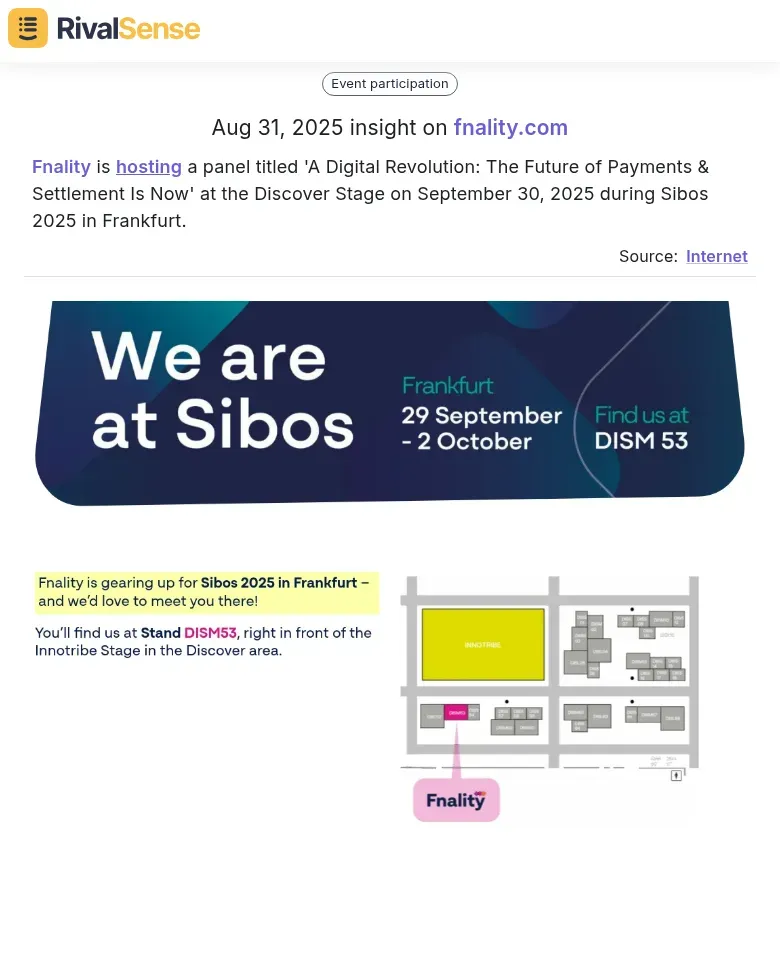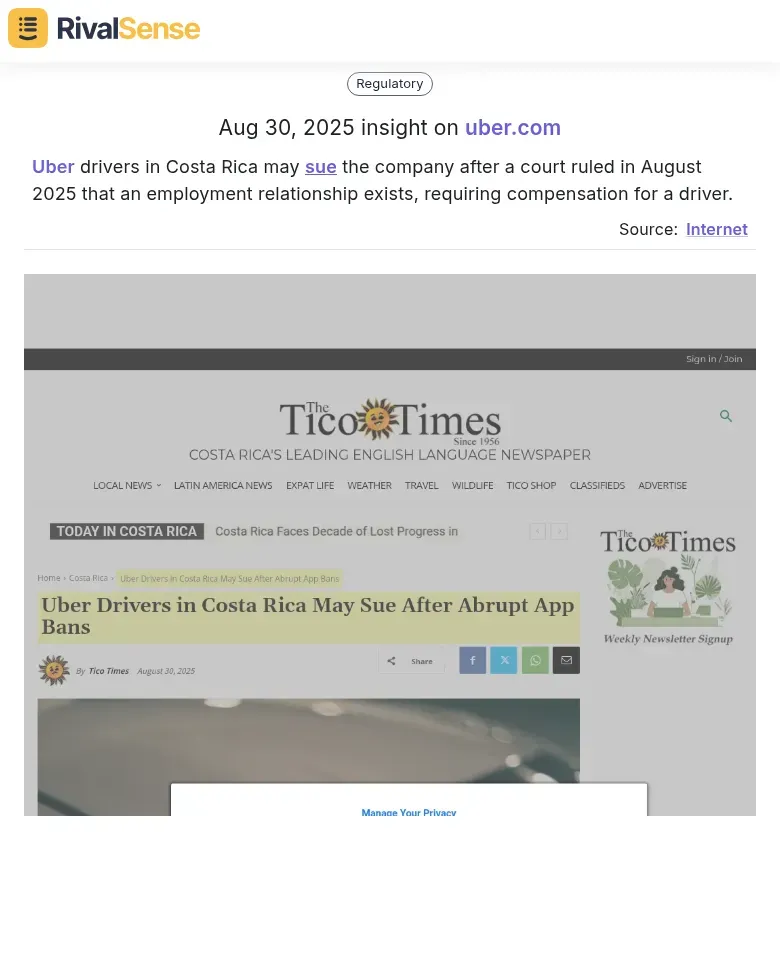Real-World Competitor Intelligence: How Internet Monitoring Drives Strategic Advantage
In today's hyper-competitive digital landscape, real-time internet monitoring has become the cornerstone of strategic decision-making for forward-thinking business leaders. By transforming raw data into actionable competitive intelligence, companies can anticipate market shifts and respond with precision. The strategic value lies in tracking competitor activities across digital channels—from product launches and pricing changes to marketing campaigns and customer sentiment—enabling data-driven decisions that drive market leadership.
Key monitoring categories include:
- 🎯 Events (product releases, webinars, conferences)
- ⚖️ Legal developments (patents, regulations, lawsuits)
- 🤝 Partnerships (strategic alliances, integrations)
- 📈 Market movements (funding rounds, acquisitions, expansions)
Practical steps to implement effective monitoring:
- Set up automated alerts for competitor mentions
- Monitor social media and review platforms for real-time sentiment
- Track website changes and SEO strategies
- Analyze job postings for strategic hiring insights
- Use competitive intelligence tools for comprehensive dashboards
This proactive approach turns digital noise into strategic advantage.
Event Intelligence: Extracting Strategic Insights from Industry Conferences
Industry conferences offer a goldmine of competitive intelligence that can shape your strategic direction. Analyzing speaker lineups and panel topics helps identify emerging trends and competitor priorities, giving you crucial market signals before they become mainstream.
Practical implementation framework:
- 📅 Monitor conference agendas 3-6 months pre-event to track competitor participation
- 📊 Create a tracking spreadsheet for speaker affiliations, topics, and key messages
- 🔍 Note product mentions or demos to gauge launch readiness
- 🚀 Time your product launches to leverage event momentum
- 📱 Use social listening tools to capture real-time reactions and expert commentary
Real-world example: Fnality is hosting a panel titled 'A Digital Revolution: The Future of Payments & Settlement Is Now' at the Discover Stage on September 30, 2025 during Sibos 2025 in Frankfurt.

Why this matters: Event intelligence helps you understand competitor thought leadership positioning and emerging focus areas. Tracking which events competitors prioritize reveals their target markets and strategic initiatives, allowing you to anticipate their next moves and identify potential partnership opportunities.
Legal & Regulatory Monitoring: Turning Compliance Risks into Competitive Opportunities
Legal and regulatory monitoring transforms compliance risks into competitive advantages by learning from competitors' legal battles and regulatory challenges. This intelligence helps you anticipate regulatory shifts and avoid costly pitfalls while identifying opportunities where competitors face constraints.
Actionable monitoring strategy:
- ⚡ Set up alerts for competitor legal filings and judgments
- 📋 Review annual labor reports and court databases quarterly for patterns
- ✅ Develop compliance checklists based on competitor precedents
- 👥 Engage legal counsel to interpret rulings and adjust strategies
Real-world insight: Uber drivers in Costa Rica may sue the company after a court ruled in August 2025 that an employment relationship exists, requiring compensation for a driver.

Strategic value: Legal monitoring provides early warning signals about regulatory trends that could impact your industry. By tracking competitor legal challenges, you can proactively update policies, avoid similar issues, and even identify market gaps where competitors face operational constraints.
Partnership Intelligence: Decoding Strategic Alliances and Market Expansion
Partnership announcements reveal critical market intelligence about competitor expansion strategies and ecosystem development. When rivals announce new alliances, they're signaling market entry plans, geographic expansion, or technology integration strategies that can impact your competitive positioning.
Practical partnership intelligence framework:
- 📢 Monitor competitor press releases and social media for partnership announcements
- 🔍 Analyze partner types (distributors, tech integrations, government agencies)
- 🗺️ Map partnership patterns over time to identify expansion trajectories
- 📊 Benchmark against industry standards for partnership frequency and types
Real-world example: HDBank partners with the Ministry of Public Security to launch a service linking accounts on the VNeID app for social security payments of 100,000 VND.

Why this intelligence matters: Partnership tracking reveals competitor market positioning and expansion strategies. Government and institutional partnerships particularly indicate regulatory alignment and market trust, helping you understand which competitors are gaining strategic advantages in regulated markets.
Actionable tip: Create a partnership matrix tracking competitor alliances by type, geography, and strategic intent. This helps identify white space opportunities and potential partnership targets for your own expansion strategy.
Implementation Framework: Building Your Internet Monitoring System
Building an effective internet monitoring system requires a structured approach that integrates technology, processes, and people. The most successful implementations combine automated tools with human analysis to create a comprehensive competitive intelligence capability.
Step-by-step implementation guide:
-
Technology Setup
- Implement automated monitoring tools like RivalSense for real-time tracking
- Set up alerts for price changes, product launches, and marketing campaigns
- Use APIs to integrate data into your CRM and analytics platforms
-
Process Design
- Create a centralized dashboard accessible to marketing, sales, and product teams
- Schedule weekly briefings to share insights across departments
- Assign team-specific KPIs (e.g., sales tracks win/loss reasons, product monitors feature gaps)
-
Response Protocols
- For urgent threats (e.g., competitor price drops): 24-hour response plan
- For strategic moves (e.g., market entry): 72-hour analysis + 2-week action timeline
- Maintain escalation matrix and predefined playbooks for common scenarios
Quick Start Checklist:
- [ ] Identify top 5 competitors to monitor
- [ ] Set up automated monitoring for each competitor
- [ ] Create alert system for critical intelligence categories
- [ ] Establish weekly intelligence review process
- [ ] Develop response protocols for different threat levels
Conclusion: Transforming Monitoring into Sustainable Competitive Advantage
Transforming internet monitoring into sustainable competitive advantage requires systematic integration into your strategic DNA. The most successful companies don't just collect competitive intelligence—they embed it into their decision-making processes and organizational culture.
Key success factors:
- 📊 Embed competitive insights into quarterly planning cycles
- 🎯 Create 'competitor dashboards' that feed into SWOT analyses
- 📈 Measure ROI through concrete metrics (win-rate improvements, market share changes)
- 🛡️ Quantify risk mitigation by documenting neutralized competitor threats
Building organizational capability:
- Establish cross-functional 'competitive intelligence councils' that meet monthly
- Implement automated alert systems for real-time competitor movements
- Develop battle cards and playbooks that are regularly updated
- Create incentive structures that reward teams for leveraging competitive insights
Remember: sustainable advantage comes not from sporadic monitoring, but from building a culture where every decision is informed by real-time competitive context.
Ready to transform your competitive intelligence? Try RivalSense for free and get your first competitor report today. Our platform tracks competitor product launches, pricing changes, event participations, partnerships, regulatory developments, and media mentions—delivering actionable insights directly to your inbox every week.
📚 Read more
👉 Actionable Step-by-Step Guide to Uncover Banking Competitor Sales Tactics
👉 How Tracking Competitor Production Shifts Can Reveal Market Opportunities
👉 Key Account KPIs Tracking: The Ultimate 2025 Guide for Strategic Growth
👉 5 Advanced HR Consulting Tactics to Transform Key Account Decision-Making
